Life in amazon basin
- Books Name
- Social Science Book
- Publication
- Cognizance Publication
- Course
- CBSE Class 7
- Subject
- Social Science
Chapter 8
Human Environment Interactions:
The Tropical and Subtropical Region
Life in the Amazon basin
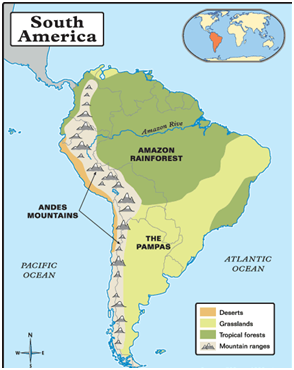
The river Amazon flows through the tropical region lies very close to the equator, between 100 N and 100 S. So it is referred to as the equatorial region.The Amazon river flows through this region.The place where a river flows into another body of water is called the river’s mouth.Numerous tributeries join the Amazon River to form the Amazon basin.The river basin drains portions of Brazil, parts of Peru, Bolivia, Ecuador, Colombia and a small part of Venezuela.
When Spanish explorers discovered the Amazon river, they were attacked by a group of local tribe wearing headgears and grass skirts. These people reminded them of the famous tribes of women warriors known in ancient Roman Empire as the Amazons. Hence the name given Amazon.
Tributaries: These are small rivers that join the main river. The main river along with all its tributaries, the drain an area forms a river basin of the catchment area. The Amazon Basin is the largest river basin in the world.
Climate
India Amazon Basin is characterized by hot and wet climate throughout the year as it is present on the equator.Both days and nights are almost equally hot and humid.skin feels sticky. It rains almost everyday. That too without much warning. The day temperatures are high with very high humidity. At night the temperature goes down, but the humidity remains high.
Rainforests
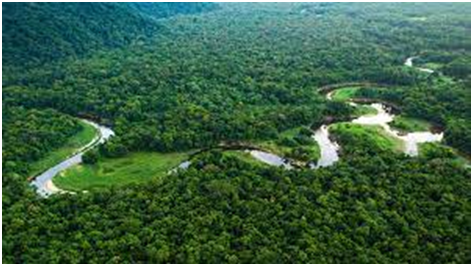
Thick forest grow due to heavy rains.The forests are so thick that the dense ‘roof’ created by leaves and branches does not allow the sunlight to reach the ground.The ground remains dark and damp.Only shade tolerant trees may grow here. Orchids,bromeliads grow as plant parasites. The rainforest is rich in fauna. Birds such as toucans, hummingbirds, mascaw with their brilliantly coloured plumage, oversized bills for eating make them different from birds found in India.
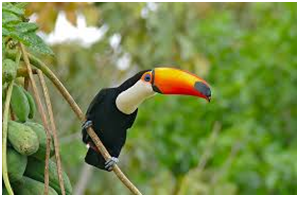
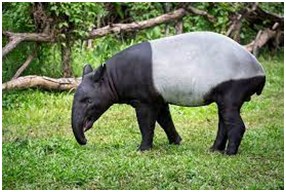
People of Rainforest
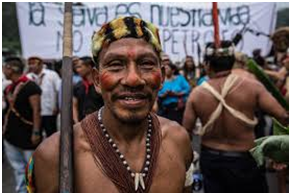
People grow most of their food in small areas after clearing some trees in the forest. While manhunt and fish along the rivers, women take care of the crops.They mainly grow tapioca, pineapple and sweet potato.As hunting and fishing are uncertain, it is the women who keep their families alive by feeding them the vegetables that they grow.They practice “slash and burn” agriculture.The staple food is manioc also known as the cassava that grows under the ground like the potato.They also eat queen ants and eggsacs. Cash crops like coffee, maizeand cocoa are also grown.Rainforests provide a lot of wood for the houses.Some families live in thachedhouses shaped like beehives, while other large apartments, like houses called “Maloca”, with a steeply , slanting roof. Life of the people of Amazon basin is slowly changing. Amazon Highway made all parts of the rainforest accessible.Aircraft and helicopters are also used for reaching various places.Population was pushed out from the area and forced to settle in new areas where they continue to practice their distinctive way of farming.Developmental activities are leading to the gradual destruction of the biological diverse rainforests.
“Slash and burn” is the way of cultivating land where farmers clear a piece of land by slashing or cutting down trees and bushes. These are then burnt, which releases the nutrients into the soil. Crops are grown in this cleared field for a few years.After repeatedly using the patch of land, the soil loses its nutrients, so it is abondoned. Then they clear another plot of land to plant.In the mean time, young trees grow in the old field. In this way, soil fertility is restored. People can then return to it and start cultivating it again.
Life in ganga Brahmaputra basin
- Books Name
- Social Science Book
- Publication
- Cognizance Publication
- Course
- CBSE Class 7
- Subject
- Social Science
Life in Ganga-Brahmaputra Basin
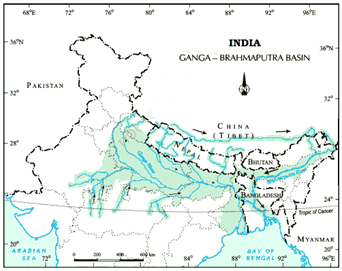
The tributaries of river Ganga and Brahmaputra together form the Ganga-Brahmaputra Basin in the Indian subcontinent.The basin lies in the subtropical region that is situated between 100 N to 230N latitudes. The tributaries of the river Ganga, like the Ghagra, the Son, the Chambal, the Gandak , the Kosi and the tributaries of Brahmaputra like Dibang River, Lohit River, Teesta, Manas drain it.
Main features of the basin:
The planes of the Ganga and Brahmaputra, the mountains and the foothills of the Himalayas and the Sundarban delta are the main features of this basin.Ox-bow lakes dot the plain area.
Climate
The areas is dominated by monsoon climate.The monsoon brings rain for mid-June to mid-September. The summers are hot and winters are cool.
Topography
The basin area has varied topography. The mountain areas with steep slopes have inhospitable terrain.Therefore less number of people live in the mountain area of the Ganga-Brahmaputra basin. The plain area provides the most suitable land for human habitation. The soil is fertile.Agriculture is the main occupation of the people where flat land is available to grow crops. The density of population of the plains is very high.Paddy is the main cropwhile other crops grown or wheat, maize, sorghum, gram, millets, jute and sugarcane.Cash crops like sugar cane and jute are also grown.Banana plantations are seen in some areas of the plain.In West Bengal and Assam, tea is grown in plantations.Silk is produced through the cultivation of silk worms in the parts of Bihar and Assam.In the mountains and hills, where the slopes are gentle, crops are grown on terraces.
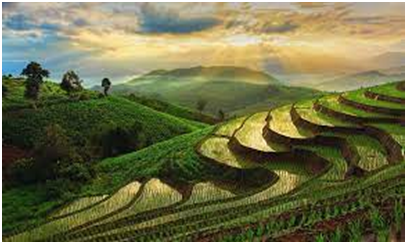
Terraces are built on steep slopes to create flat surfaces on which crops are grown. The slope is removed so that water does not run off rapidly.
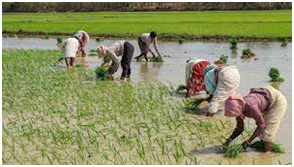
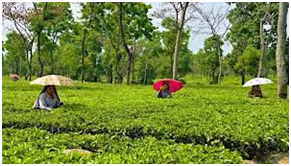
Population density- It means the number of persons that live in one sq. km of area e.g. the population density of Uttarakhand is 189 while the density of West Bengal is 1029 and that of Bihar is 1102.
Vegetation
The vegetation cover of the area varies according to the type of landforms.In the Ganga and Brahmaputra plain, tropical deciduous trees grow, along with teak, sal and peepal. Thick bamboo groves are common in the Brahmaputra plain. The delta area is covered with the mangrove forests. In parts of Uttarakhand, Sikkim and Arunachal Pradesh, coniferous trees like pine, deodar and fir can be seen because the climate is cool and the slopes are steep.
Wildlife
Elephants,tigers,deer and monkeys are common.The one-horned rhinoceros is found in the Brahmaputra plain. In the delta area, Bengal tiger, crocodiles and alligators are found.Aquatic life abounds in the fresh river waters, the lakes and the Bay of Bengal Sea. The most popular variety of the fish rohu, catlaand hilsa.Fish and rice is the staple diet of the people living in the area.
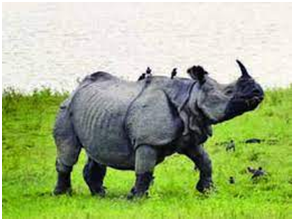
Towns and cities
The cities of Allahabad, Kanpur, Varanasi, Lucknow, Patna and Kolkata all with the population of more than ten lakhs are located along the River Ganga.The waste water from these towns in industries is discharged into the rivers which pollute the river.
In the fresh rivers ofRiver Ganga and River Brahmaputra, a variety of dolphins locally called ‘Susu’ also called blind dolphin is found.The presence of susu is indication of the health of the river. The untreated industrial and urban waste with high amount of chemicals are killing these species.
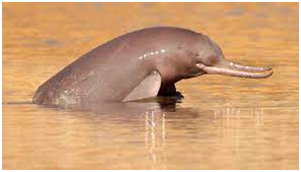
To accelerate the efforts to achieve universal sanitation coverage and to put fours on sanitation, the Prime Minister of India launched the “Swatch Bharat Mission” on 2nd October 2014.
To conserve the river ganga “Namami Ganga” programme has been initiated.
Transportation
Ways of transport are well developed in the Ganga Brahmaputra basin.In the plain areas, the roadways and railways transport the people from one place to another.The waterways is an effective means of transport, particularly along the rivers.Kolkata is an important port on the “River Hooghly”.The plain area also has a number of airports.
Tourism centres
Tourism is another important activity of the basin. Taj Mahal on the banks of River Yamuna in Agra, Allahabad on the confluence of the Rivers Ganga and Yamuna.Buddhists stupas in Uttar Pradesh and Bihar, Lucknow with its Imambara, Assam with Kaziranga and Manas with wildlife centuries in Arunachal Pradesh with a distinct tribal culture or some of the places worth a visit.
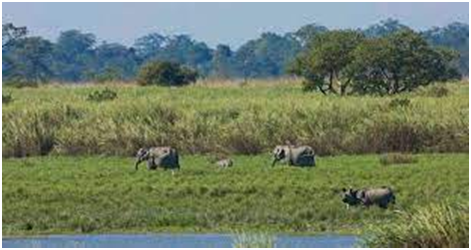

 Cognizance Publication
Cognizance Publication
